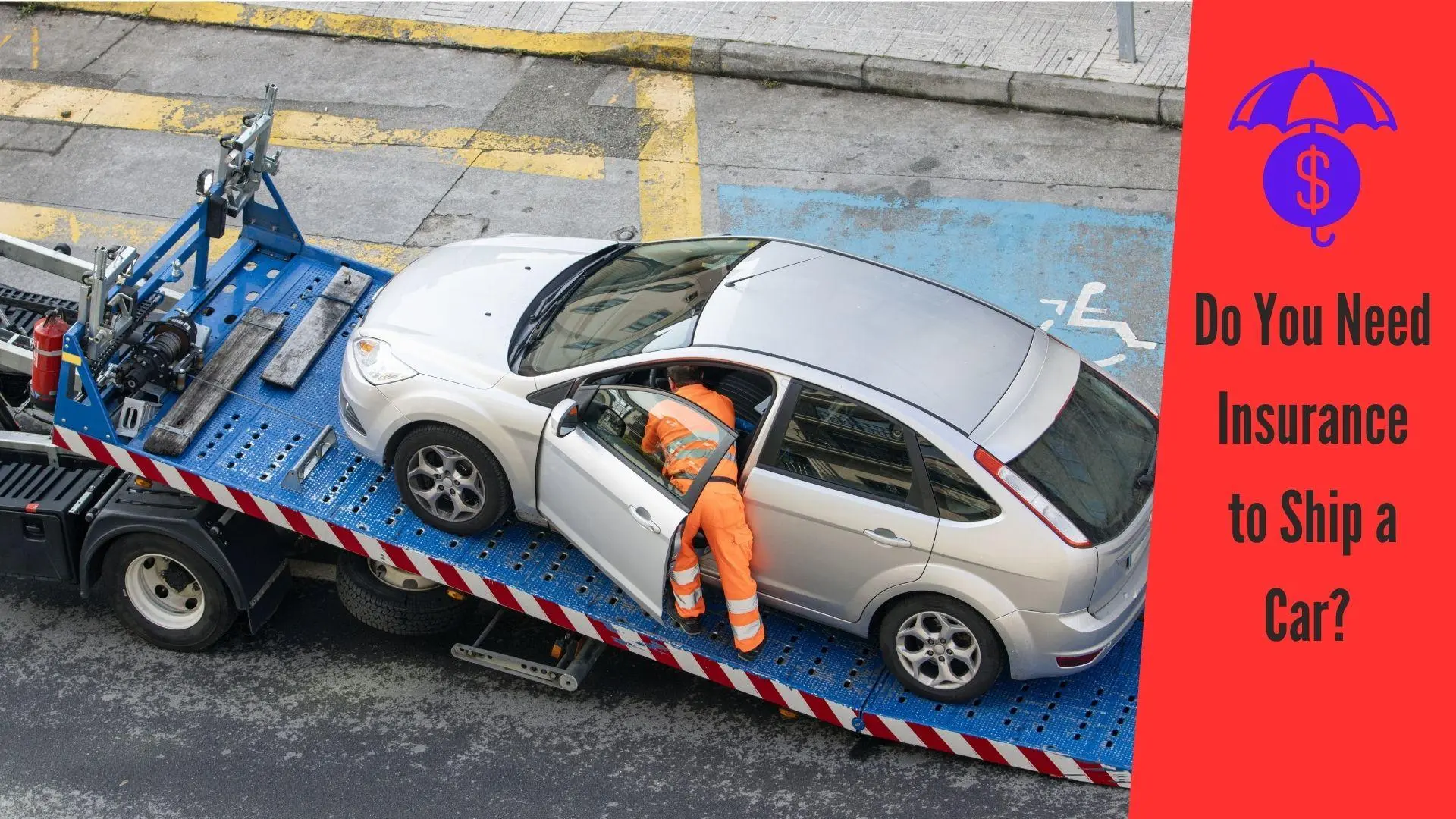Your car is not just an asset; it’s a valued possession that deserves top-notch care during transportation. That’s where auto transport insurance comes in, serving as a safety net should anything unexpected occur during transit. Questions about the necessity of auto transport insurance abound, from “Is it essential?” to “What does it cover?” and “How much does car shipping insurance cost?” We’ll address these common concerns and provide clarity to make your auto transportation as seamless as possible. With Easy Auto Ship, we’re not just moving cars but ensuring peace of mind.
Auto transport insurance plays an integral role in securing the safety of your vehicle during transit. This type of coverage is often a concern for many people, considering the possible risks of shipping a car. Now, you might wonder, “How much is insurance for a car hauler?” The auto transport insurance cost can vary depending on several factors, including the value of your vehicle and the distance it needs to be transported. But remember, the peace of mind that comes with knowing your car is protected during transit is invaluable.
Furthermore, many people often ask, “Do you need insurance to ship a car?” The answer is a resounding yes! Auto transport insurance is not just a precaution; it’s a requisite for ensuring your car’s safe journey from point A to point B. With it, you could avoid damages out of pocket. So, while you might be tempted to skip out on car shipping insurance to save a few bucks, it’s a decision that could cost you a good deal more in the long run. So, when shipping your auto, don’t gamble with its safety - pay the auto transport insurance cost for a worry-free journey.
Why Insurance Matters in Car Shipping?
When doing car shipping, many people often wonder, “Do you need insurance to ship a car?” There are several reasons why insurance is essential in car shipping, and it’s not just because it’s the law. Having insurance provides peace of mind and financial protection. Think of auto transport insurance as a safety net, ready to catch you if something unexpected occurs during shipping.
Auto transport insurance may seem like an additional expense, but it’s worth every penny, considering the potential risks and liabilities involved in shipping without insurance.
Risks and Liabilities of Shipping Without Insurance
Shipping a car without insurance is like playing Russian roulette - you might get lucky most times, but that one unfortunate time could cost you dearly.
For instance, you hire a hauler to transport your prized classic car. Halfway through the journey, a freak hailstorm damages your vehicle.
Without car shipping insurance, you can bear the price of repairs or, in the worst-case scenario, complete loss of your car.
Legal Requirements for Car Insurance During Transit
Insurance isn’t just a good idea when you ship a car - it’s a legal requirement for car transporters. The law stipulates that all vehicles in transit must have cargo insurance coverage. This is to ensure that, should an accident occur during the shipping process, the repair or replacement costs can be covered.
Insurance coverage also serves as financial protection against theft or damage due to unforeseen circumstances like extreme weather conditions.
Who is responsible for car shipping insurance?
Auto transport carriers are the ones who need to have cargo insurance coverage as they have a legal obligation to carry insurance. This transport insurance covers any damages that may occur while the car is in its possession.
For example, if a car is damaged while being loaded onto the transport truck, auto transport insurance will cover the repairs. Transport insurance also covers damages that may occur due to accidents during transit.
Before selecting a shipping company, car owners must ask about the transport insurance price and coverage. So, regarding the requirements to ship a car, insurance is non-negotiable, both for your peace of mind and for your wallet’s sake. At Easy Auto Ship, all our carriers have at least $100k cargo coverage.

What Are Auto Transport Insurance Requirements?
Different types of carriers, such as open and enclosed, have different levels of coverage, with enclosed being the highest.
- When it comes to the price of auto transport insurance, it depends on a variety of factors. Firstly, the value of the car. A more expensive automobile will require more coverage and thus cost more.
- Moreover, the type of car hauler you choose - open or enclosed - will also affect the cost. An enclosed car hauler will be more expensive than an open one.
- Lastly, the distance you are shipping your car affects the insurance price A more extended trip will require more insurance coverage and, therefore, more money. Finally, the type of transport insurance you choose will also affect the quote.
It is essential to consider all these factors when determining how much insurance you need for your car shipment. Do your research and shop around to find the best deal.
At Easy Auto Ship, we provide our customers with the best rates on car shipping insurance, so you can relax knowing that you will get the most coverage for the best price.
Types of Transport Insurance Coverage for Car Transport Damage
When we think about shipping a car, the question, “Do you need insurance to ship a car?” often pops up. Let’s put it this way - imagine you’ve got a shiny new sedan you’re sending halfway across the country. Wouldn’t you want to ensure it’s well-protected? Absolutely, right? Now, let’s dive into the types of insurance coverage that can safeguard your precious vehicle during transport.
- Cargo Insurance. This is the knight in shining armor the transport carrier purchases to cover any damage to your car while in transit. It’s like a safety blanket that wraps around your car, shielding it from the uncertainties of the journey. For instance, suppose your car encounters an unexpected hail storm during transport, resulting in a few unsightly dents. Thanks to Cargo Insurance, your car’s beauty treatment is taken care of and can continue to shine!
- Liability Insurance. The auto transport company carries this coverage and acts as a financial safety net should anything happen to your car during transport. Think of it as a superhero, swooping in to save the day if your car suffers damage due to an accident on the road. So, if your car hauler takes an unfortunate tumble down a hillside, Liability Insurance steps in, covering the repair prices your vehicle and making it road-worthy again.
- GAP Insurance. This is an additional cover you can opt for if you feel your car needs more insurance than the transporter offers. It’s like that extra layer of bubble wrap you might use to protect a fragile item. Suppose you own a luxury sports car worth more than the standard auto transport insurance coverage. In this case, GAP Insurance comes to the rescue, bridging the financial gap between the transport insurance value and the actual value of your car.
Ensuring Sufficient Coverage - How much insurance coverage is needed for car shipping?
All right, let’s jump into the core details of ensuring that your car transport insurance cost is as snug as a bug in a rug.
Verifying Terms and Coverage Amount
Now, imagine you are sipping your morning coffee while going through the coverage terms and conditions offered by your car transport company. You come across terms that mention theft, natural disasters, and even total destruction of your car. Your eyebrows furrow as you wonder, “Are these covered?” This is a good question, dear friend. You’re right to ask because not all auto transport insurance plans cover these events. It’s like buying a sandwich without knowing what’s inside! So, it’s crucial to understand the extent of protection provided.
Let’s illustrate this with an example. Picture your prized car, a shiny red convertible, transported across the country. Out of nowhere, a twister appears on the horizon. Your vehicle, unfortunately, meets the brunt of the storm. If your car shipping insurance does not cover natural disasters, you’ll be left to bear repair or replacement quotes.
Imagine your Mustang being transported across the stormy seas, and suddenly, Poseidon decides to show his power. Your car shipping insurance should have your back, shouldn’t it?
Calculating the Right Coverage
Now, on to the next important aspect - calculating the proper coverage. To begin, you need to consider the actual value of your vehicle. It’s like knowing how much your house is worth before you insure it. You wouldn’t want to cover it for less than it’s worth, would you? So, contact dealerships, scout listings for similar vehicles for sale online, or use tools like Kelly Bluebook. Once you have a clear picture of your car’s value, it’s time to evaluate the need for additional coverage.
For example, let’s say your car’s value is more than the coverage offered by car hauling insurance. In such cases, consider additional coverage. It’s like buying an expensive painting but insuring it for less. You wouldn’t want to do that.
Once you have a good idea about your car’s value, see if it exceeds the coverage amount offered by the transporter. If it does, it’s an excellent time for a serious chat with your transporter. Let them know your car’s value and discuss the requirements to ship a vehicle. Ask them if additional coverage is necessary - remember, your car deserves the royal treatment!
Enclosed Vs Open Transport?
Open car trailers offer less security but are a lot cheaper. However, they also come with limited or sometimes very minimal insurance coverage. Remember, the coverage might not fully cover certain types of damage, or there might be limits on the maximum reimbursement amount.
On the other hand, enclosed car transport trailers have higher security since the vehicles are moved in a fully covered container. And carriers mostly get higher insurance coverage since they know they’re moving highly valuable vehicles. They often offer coverage that can fully compensate for damages incurred during transit, including accidents and unforeseen incidents.
| Aspect | Enclosed Car Shipping Carrier | Open Car Shipping Carrier |
|---|---|---|
| Protection Level | High | Moderate to Low |
| Weather Exposure | Minimal | High |
| Security | More secure | Less secure |
| Insurance Coverage | Extensive | Limited |
| Cost | Higher | Lower |
| Vehicle Types | Luxury, Classic, Exotic | Regular, Economy |
| Damage Risk | Lower | Higher |
| Special Handling | Yes | No |
| Suitable For | High-value vehicles | Standard vehicles |
| Protection from Debris | Yes | Limited |
| Delivery Time | Potentially Longer | Potentially Faster |
So you decide whether you want more coverage and higher security or less coverage, less security but at least a 25% reduction in transport prices.
Tip: You can also get GAP insurance along with an open carrier if your vehicle’s value exceeds the coverage offered by the carrier.
Best Insurance-Related Practices for Car Transport
Obtaining Proof of Insurance
Let’s begin by discussing the necessity of obtaining proof of insurance. When you hire a car transport company, you must ask for their auto transport insurance certificate. This isn’t a mere formality; it’s your right as a customer. The law requires all car haulers to have valid insurance.
While it might seem like an extra step, verifying the insurance ensures that the company is legitimate and has adequate coverage to handle your car. Imagine this scenario; you’re shipping your 1965 Mustang. The car transport company assures you they’re insured but are hesitant to show you the certificate. You decide to trust them anyway.
Unfortunately, the car gets damaged during transport. Without a verified insurance certificate, you’re left in a lurch, trying to sort out the mess. It’s a nightmare scenario. Always verify the car shipping insurance before handing over your precious vehicle to avoid such situations.
Consulting Your Own Auto Insurance Provider
Next up, let’s talk about consulting your auto insurance provider. Yes, you heard it right! While the car transport company’s insurance is crucial, knowing what your auto insurance covers during the transport process is equally important. Remember, knowledge is power. Knowing your car shipping insurance limitations can save you from potential coverage gaps. Let’s take an example of someone who’s decided to ship their car across the country.
They contacted their insurance provider and found out the policy covered the car during transport, but only if it is moved within the same state, it is registered in. This means they won’t be covered in Florida if they have Californian license plates. So, don’t assume automatic coverage in every case; call your insurance provider to discuss the specifics of your car hauling insurance cost and coverage.
Documenting the Vehicle’s Condition
Finally, documenting your car’s condition before transport is a practice you should pay attention to. It’s not just about handing over your car keys and waving goodbye. You need to conduct a thorough pre-transport inspection and take detailed photos of your car. This documentation records your car’s condition before shipping and can be incredibly useful if a damage dispute arises.
Let’s say you’re a classic car enthusiast. You ship your prized 1957 Chevy Bel Air to an auto show. Before transport, you meticulously document the car’s condition with photos and share them with the transport company.
Unfortunately, the car experiences some damage during shipping. But thanks to your detailed documentation, you can prove the damage is not pre-existing and successfully file a claim. So, the moral of the story? Document, document, document!
Parting Words:
The essence of auto transport insurance lies in its ability to provide a robust safety net for vehicle owners, mitigating financial risks associated with potential damages during transport.
Its importance is multiplied when one considers the unpredictability of weather conditions, road accidents, or mechanical issues that could jeopardize the shipping process.
Therefore, hiring an auto transport company with decent car insurance coverage, like Easy Auto Ship, is indispensable as we offer at least $100k coverage.





